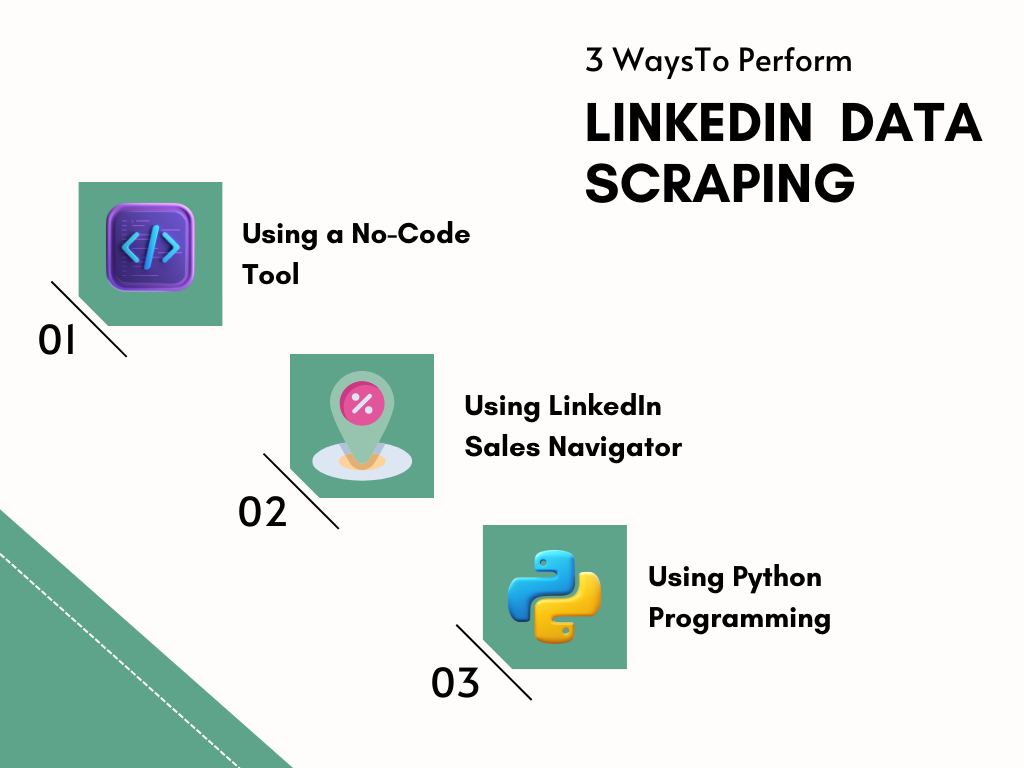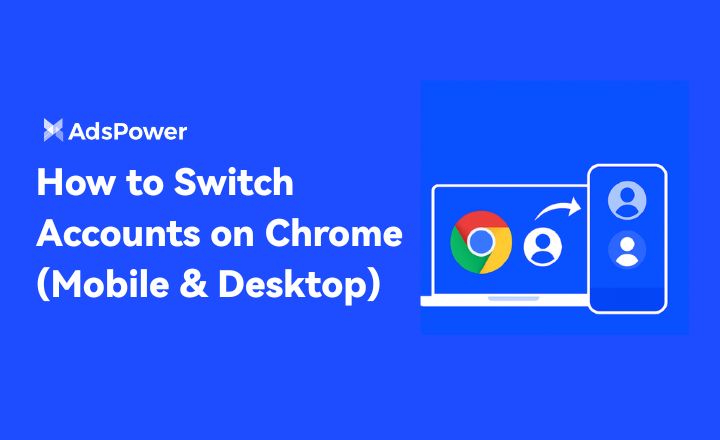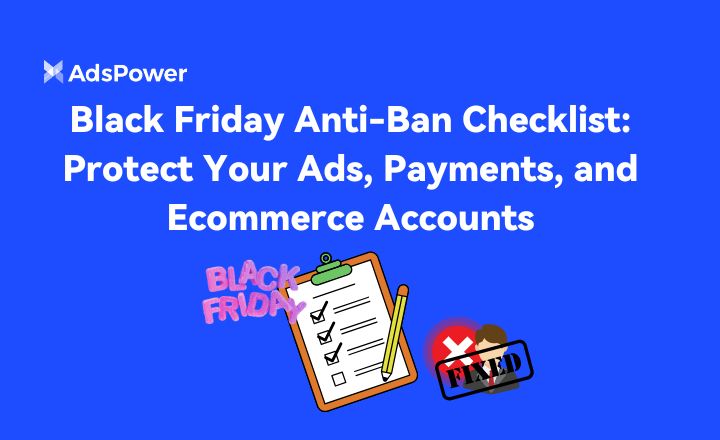How to Scrape LinkedIn: 3 Methods With and Without Coding
LinkedIn is arguably the largest professional platform out there, catering to a diverse audience including freelancers, employees, executives, and even founders. With over 1B+ professional users, LinkedIn is a goldmine with rich information about individuals that hold multiple benefits for businesses.
This is where LinkedIn scraping proves to be a game-changer as it provides a helping hand to businesses on mainly two fronts – boosting sales by finding potential clients and making hiring easier for the HR department.
In this blog, we'll explore how to scrape LinkedIn in three ways, ranging from user-friendly no-code tools to more advanced methods involving coding.
Additionally, you’ll also learn LinkedIn’s stance regarding scraping data from LinkedIn profiles and lastly, we’ll suggest a way to scrape LinkedIn without getting detected.
Before diving right into it, let’s understand some use cases of LinkedIn scraping.
How Is LinkedIn Scraping Beneficial?
Web scraping LinkedIn offers tons of benefits. The main advantage is getting rid of manually browsing profiles and collecting relevant information. Using a LinkedIn scraping tool, you can scrape information from a large number of profiles in just a matter of seconds. On top of that, these tools also let you export the gathered leads in an organized format.
Moreover, web scraping LinkedIn contributes significantly to business operations. The hiring process is a perpetual cycle in the job market. HR professionals can leverage LinkedIn scraping to construct a comprehensive dataset of potential employees and approach them to quickly fill up vacancies at their firm.
Similarly, businesses can utilize LinkedIn scraping to collect information about potential clients. They can extract their emails and phone numbers to reach out to them to market their products and increase sales.
Furthermore, many LinkedIn scraping tools also offer the feature to mass send emails to all the contacts in the leads list. This not only streamlines the responsibilities of a salesperson but also saves valuable time in the process.
3 Sure-Shot Ways to Perform LinkedIn Data Scraping

There are multiple ways you can perform LinkedIn data scraping. But which one is suitable for you? Well, it depends on your needs. If you are on a budget and don’t want to hire a web scraping expert, you can use a no-code tool to scrape LinkedIn.
On the flip side, if you have the budget and want to scrape data in bulk, you may hire a developer to get the job done for you. Regardless, here are 3 ways to scrape LinkedIn:
- LinkedIn Scraping Using a No-Code Tool
- LinkedIn Scraping Using Sales Navigator
- Scrape Data From LinkedIn Using Python
LinkedIn Scraping Using a No-Code Tool
Many founders or marketers wanting to scrape LinkedIn may not have coding expertise or the budget to hire an expert. And besides, why should LinkedIn scraping be a coders-only job anyway? This is what no-code web scraping tools are built for.
They make web scraping accessible to a wider audience by offering an interactive platform where most of the work is done through clicks. And for LinkedIn, you don’t even have to install most of these tools since they come in the form of browser extensions.
If you're in search of a no-code LinkedIn scraping tool, consider some of the leading options: Kaspr, PhantomBuster, Lusha, Cognism, and Dux-Soup. These tools let you extract data such as phone numbers, email addresses, and company info from multiple platforms including LinkedIn, Recruiter Lite, Sales Navigator, and more.
In this article, we’ll use Kaspr to walk you through the LinkedIn web scraping process.
Here's how to scrape LinkedIn using Kaspr:
- Step 1: First, install the Kaspr Chrome extension in your browser from the Chrome Webstore here. You can also get started for free from their website.
- Step 2: Once the extension is installed, you’ll have to make an account on Kaspr using your email. Follow the on-screen instructions and set up your account.
- Step 3: Now open LinkedIn and go to any target profile. Meanwhile, you’ll see the Kaspr widget hovering on the right side of the screen. The widget will notify you if it could gather any data from the profile.

- Step 4: Once there are notifications on the Kaspr widget, open it and you’ll be able to add the gathered information to your leads list. You can view the leads list in the Kaspr Dashboard opened in the side tab. You can find out additional information too using credits.

- Step 5: When you have gathered enough leads, you can export them in a CSV or Excel file.
The Kaspr Dashboard also lets you enrich the data to fill in the missing fields and complete the records. The data enrichment workflows allow you to enrich emails and both personal and business phone numbers. You can also launch an automated process to gather data in bulk without manually going to each profile. On top of everything, it also lets you send mass emails to the leads.
Scrape Data From LinkedIn Using LinkedIn Sales Navigator
Another valuable tool that can help with scraping data from LinkedIn is LinkedIn Sales Navigator. The Sales Navigator isn’t itself a LinkedIn scraping tool, but it lets you gather leads in bulk that you can later export using tools like Prospeo.
The real power of LinkedIn Sales Navigator lies in its ability to find quality leads for you. Since it’s LinkedIn’s in-house tool, It provides you with deeper access to the global network of professionals on LinkedIn and gives you access to Advanced Search filters that automatically single out potential prospects more likely to engage with you.
With advanced search filters, you can narrow down leads based on region, industry, function, and designation. The sales navigator also has the Spotlight feature that uses the following filters to find noteworthy leads:
- Job Changes: Find prospects who switched jobs within the last three months.
- Shared Experience: Filters out prospects that come from the same places as you (School, Company, or LinkedIn Groups).
- LinkedIn Activity: Identifies prospects that made or shared posts on LinkedIn within the past month.
- Mentioned in the News: Shows prospects that got media attention within the past 30 days.
- Leads that Follow Your Company: Brings up profiles that follow your Company’s LinkedIn account.
- TeamLink: Lists prospects from the network of company colleagues.
The sales navigator also tracks the real-time activity of your favorite leads through updates and alerts. For instance, it notifies you when a lead shares a personal story on LinkedIn that you can interact with to build genuine trust.
Here’s a quick overview of how to scrape LinkedIn via the LinkedIn Sales Navigator:
- Create an account on Prospeo.io
- Go to Chrome Store and Add the Prospeo extension.
- Open LinkedIn Sales Navigator. You’ll now see the “Export with Prospeo” button parallel to the search bar.
- Now set appropriate search filters and do a lead search.
- The page will load the filtered results. To extract all the results, simply click the “Export with Prospeo” button at the top and you’ll be directed to the Prospeo Dashboard.
- Name your extraction list and press extract.
- Once the extraction is complete you can export the bulk either in Excel or CSV format.
Web Scraping LinkedIn Using Python Programming
In the previous LinkedIn scraping methods, we showed you how to scrape LinkedIn without coding. But it's possible you might not get your desired data through a LinkedIn scraping tool. These tools also charge a subscription fee, especially for accessing additional data such as personal phone numbers which can put a strain on your budget.
This is where you’ll need to use coding methods to scrape data from LinkedIn. Coding to scrape LinkedIn data involves writing custom scripts or programs using programming languages such as Python, JavaScript, or others to specifically target and extract data from LinkedIn profiles.
While this method offers increased flexibility and customization, it demands a moderate to deeper level of coding proficiency. If you want to learn how to scrape data from LinkedIn for free and you also have programming skills, this is the ideal method for you.
To get started, you'll need Python installed on your system and essential libraries like Beautiful Soup, Selenium, Pandas, regex, etc. Additionally, a WebDriver and a code editor are also necessary components.
For further guidance, you can refer to the step-by-step Python code snippets in our ecommerce website scraping guide, which can assist you in understanding how to scrape data from LinkedIn using Python.
Is It Legal To Scrape Linkedin?
LinkedIn is strictly against web scraping as explicitly stated in its User Agreement. In the past, LinkedIn has taken legal action against companies and individuals who were caught going against this policy.
The platform employs robust security measures that actively identify bot behavior and block crawlers and web scrapers. For instance, if your coding script or LinkedIn scraping tool rapidly browses through multiple profiles, it significantly raises the risk of triggering LinkedIn's anti-scraping mechanism, leading to temporary or permanent blocks.
Given that both coding and no-code methods are detectable, the question arises: how to scrape LinkedIn without getting blocked? The solution is simple: use an anti-detect browser like AdsPower for LinkedIn data scraping.
AdsPower masks your crawler’s identity by mimicking regular user behavior. It uses techniques such as fingerprint spoofing and IP rotation to keep the crawler’s identity hidden.
It’s also highly recommended to use an anti-detect browser even when scraping LinkedIn through a LinkedIn scraping tool, as these tools are often linked to your LinkedIn account. Using an anti-detect browser helps mitigate the risk of losing access to your LinkedIn profile in case the tool gets detected.
In a Nutshell
Whether your goal is to find potential clients, hire the right people, or extract your target audience’s emails to do cold outreach for your business, LinkedIn scraping can help you achieve your goal.
The process doesn't necessarily demand coding skills, thanks to numerous no-code tools. Tools like Kaspr let you scrape data from LinkedIn and export it to Excel or CSV format.
On the other hand, LinkedIn Sales Navigator provides broader access to the LinkedIn network and advanced search filters for targeted lead generation.
For those with coding skills, Python programming allows for maximum flexibility and customization and also offers a free way to scrape data from LinkedIn.
Despite the advantages, it's crucial to note LinkedIn's strict policy against scraping can lead to account suspension as well as potential legal consequences. To avoid these issues, anti-detect browsers like AdsPower offer a robust solution to steer clear of LinkedIn’s anti-scraping mechanism.
“Scrape, but Scrape Safely.”

People Also Read
- How to Switch Accounts on Chrome (Mobile & Desktop)

How to Switch Accounts on Chrome (Mobile & Desktop)
Learn how to switch accounts on Chrome for desktop and mobile. Avoid data mix-ups, manage multiple Google accounts safely, and use profiles for separa
- Black Friday Anti-Ban Checklist: Protect Your Ads, Payments, and Ecommerce Accounts

Black Friday Anti-Ban Checklist: Protect Your Ads, Payments, and Ecommerce Accounts
Protect your ads, payment gateways, and ecommerce accounts this Black Friday with a proven anti-ban checklist and AdsPower strategies to avoid flags
- The Solo Marketer's Black Friday Superpower: Scaling Like an Agency with AdsPower

The Solo Marketer's Black Friday Superpower: Scaling Like an Agency with AdsPower
Solo marketer for Black Friday? Learn how to scale your ads, safely manage multiple Facebook & TikTok accounts, and automate tasks with AdsPower.
- Play Roblox Without VPN: Safe and Easy Ways to Access Roblox

Play Roblox Without VPN: Safe and Easy Ways to Access Roblox
Discover how to play Roblox without a VPN in 2025 safely and easily. Learn working methods, safe practices, and tips to enjoy Roblox anywhere.
- How Can I Make Money on Fiverr? (Beginner’s Guide to Earning Online)

How Can I Make Money on Fiverr? (Beginner’s Guide to Earning Online)
Learn how to make money on Fiverr in 2025 with this beginner’s guide. Discover top niches, expert tips, and how to scale your freelancing business


